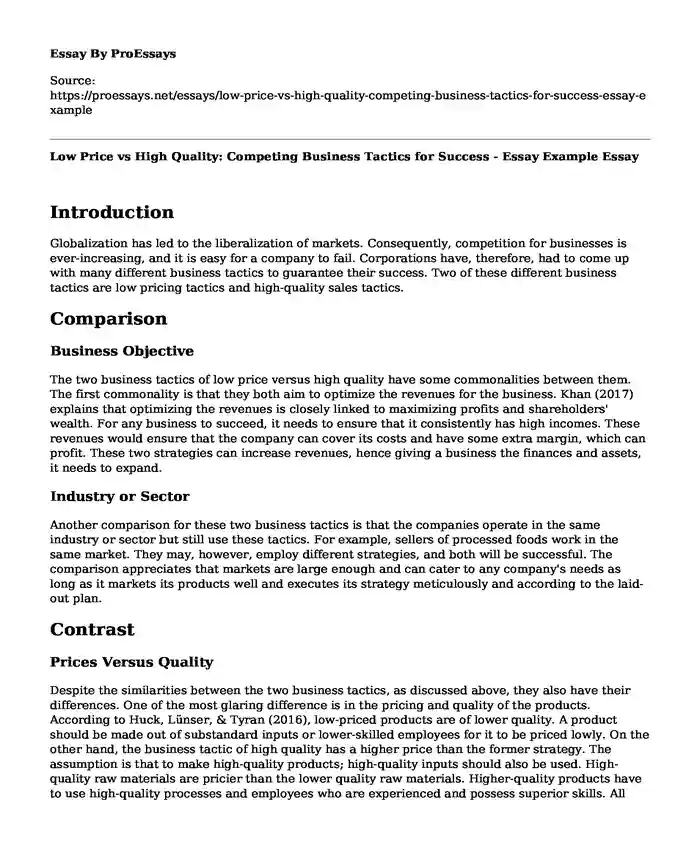Introduction
Globalization has led to the liberalization of markets. Consequently, competition for businesses is ever-increasing, and it is easy for a company to fail. Corporations have, therefore, had to come up with many different business tactics to guarantee their success. Two of these different business tactics are low pricing tactics and high-quality sales tactics.
Comparison
Business Objective
The two business tactics of low price versus high quality have some commonalities between them. The first commonality is that they both aim to optimize the revenues for the business. Khan (2017) explains that optimizing the revenues is closely linked to maximizing profits and shareholders' wealth. For any business to succeed, it needs to ensure that it consistently has high incomes. These revenues would ensure that the company can cover its costs and have some extra margin, which can profit. These two strategies can increase revenues, hence giving a business the finances and assets, it needs to expand.
Industry or Sector
Another comparison for these two business tactics is that the companies operate in the same industry or sector but still use these tactics. For example, sellers of processed foods work in the same market. They may, however, employ different strategies, and both will be successful. The comparison appreciates that markets are large enough and can cater to any company's needs as long as it markets its products well and executes its strategy meticulously and according to the laid-out plan.
Contrast
Prices Versus Quality
Despite the similarities between the two business tactics, as discussed above, they also have their differences. One of the most glaring difference is in the pricing and quality of the products. According to Huck, Lünser, & Tyran (2016), low-priced products are of lower quality. A product should be made out of substandard inputs or lower-skilled employees for it to be priced lowly. On the other hand, the business tactic of high quality has a higher price than the former strategy. The assumption is that to make high-quality products; high-quality inputs should also be used. High-quality raw materials are pricier than the lower quality raw materials. Higher-quality products have to use high-quality processes and employees who are experienced and possess superior skills. All these significant inputs will have to be factored into the final price of the products. Ultimately, the cost of using these high-quality business tactics leads to higher rates.
Target Market
Another significant difference between these two tactics is the target market. In the demand for any products, it is common to find consumers willing and able to pay different prices. These differences in rates are due to differences in the outcomes. Wang, Hu, & Liu (2017) explain that price-sensitive customers want products that are priced lowly. The low prices they are charged for these goods and services are willing to compromise on quality. On the flip side, the customers targeted by the other high-quality products business tactic are eager and able to pay the higher price (Wang et al., 2017). For them, quality is the only consideration. An excellent example of this is the Apple smartphone buyers. Many other cheaper smartphone phones from Samsung and Huawei companies exist, but they prefer Apple because of the perceived high quality and reliable brand.
Conclusion
The two business tactics of low price versus high quality have their similarities and differences. Both have their target market. None of the tactics can be classified as being better than the other. Instead, a business should study its internal and external realities to decide which of the two suits it best.
References
Huck, S., Lünser, G. K., & Tyran, J. R. (2016). Price competition and reputation in markets for experience goods: An experimental study. The RAND Journal of Economics, 47(1), 99-117.Khan, Z. A. (2017). Profit maximization as an objective of a firm-A robust perspective. International Journal of research in Finance and Marketing, 7(6), 217-219.
Wang, S., Hu, Q., & Liu, W. (2017). Price and quality-based competition and channel structure with consumer loyalty. European Journal of Operational Research, 262(2), 563-574.
Cite this page
Low Price vs High Quality: Competing Business Tactics for Success - Essay Example. (2023, Oct 26). Retrieved from https://proessays.net/essays/low-price-vs-high-quality-competing-business-tactics-for-success-essay-example
If you are the original author of this essay and no longer wish to have it published on the ProEssays website, please click below to request its removal:
- Importance of Relationship Marketing Essay
- Essay Sample on Advertising for the Elderly
- Polaris Industries Company Marketing Analysis Essay
- Essay Sample on Capitalization of Systems
- Humanitarian Crisis Relief: How NGOs Save Lives - Essay Sample
- Paper Example on Acronyms for Sustainable Development: GDP, GIP, GREET, GTU, LUMP, NEEAP, NUAF, RSS, SA, SEAP, SMSG, UHI
- Paper Example on IHRM: 7 Key Strategies for Global Market Success







